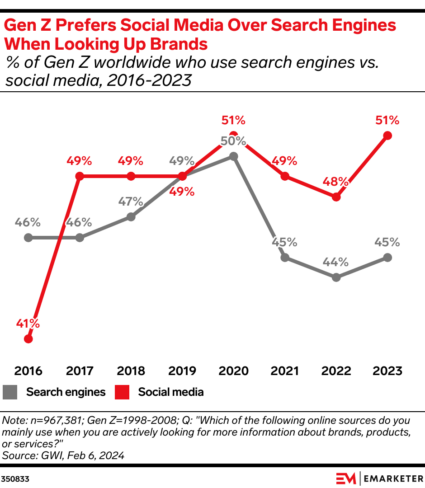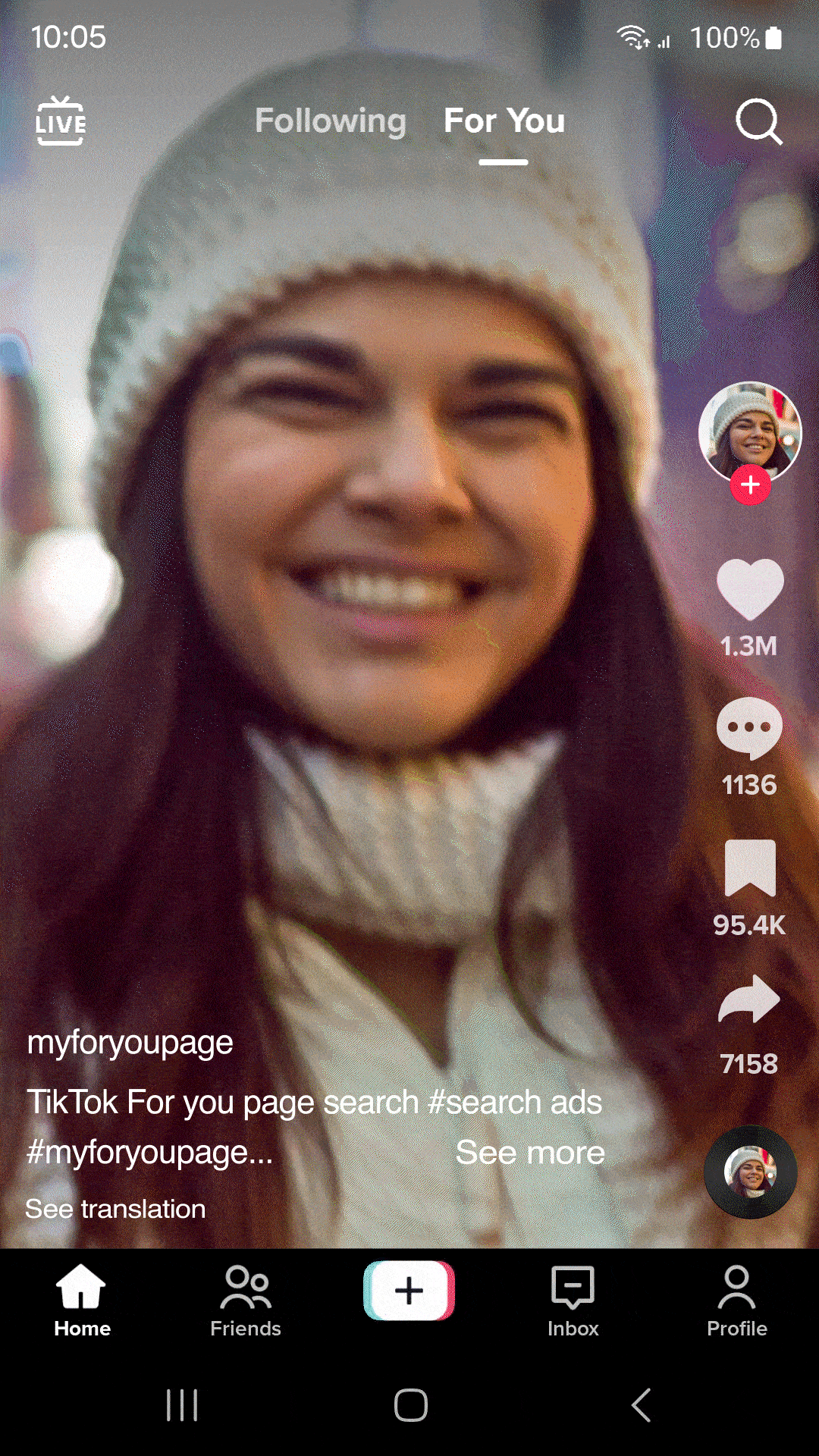Every marketer has probably heard that “social is the new search.” Audiences are increasingly turning to social media platforms like TikTok and YouTube to seek out information on trends, get first-hand insights into current events, and find reviews on products and experiences.
But that doesn’t mean that social media has become a replacement for traditional search engines like Google or Bing. Instead, social has become an alternative place for searchers to find real-life perspectives from peers in a visually engaging format.
For today’s consumers, search is about more than just pulling up an answer–it’s about finding the information they’re looking for from sources they know they can trust. So what does that mean for marketers trying to cut through the noise and show up where their consumers are?
Getting started with social search
Although standard Google and Bing searches still make up an important share of search, social media platforms have made major strides in recent years. Social platforms are often quicker, more relevant, more trusted, more visual, and more engaging than traditional search engines, which gives them an advantage with the way consumers find brands and become loyal today.
No matter what your search strategy looks like right now, you should be considering how to diversify your search investment beyond Google and Bing. The way people search is changing, and brands that are still clinging to the traditional model of blue links on the SERP may find themselves left behind as channels like social media take up a greater share of search and even traditional search engines begin to incorporate more social media results into their algorithms.
If you’re ready to tap into the social advantage by investing in search on these platforms, it can be tough to figure out what to prioritize with nearly countless platform options. Before you decide which social platform to invest in, start by finding out where your audience spends time.
According to GWI, Gen Z prefers social media over search engines when looking up brands. They’re also using social search to learn: tutorials and how-tos are among their most searched topics on social, likely because they often like visual results more than text-based content.
-

Source: eMarketer
But it’s not just Gen Z using social for search. A survey by Jungle Scout found that nearly a quarter of Millennials started online product searches on TikTok, Instagram, or Facebook, while 20% of Gen Xers started on Facebook. Depending on the age of your audience, you might choose to focus on different platforms they might prefer, like choosing Facebook over TikTok for older customers.
You can also consider other factors, like which platforms are the most popular for the type of products or content your brand is sharing. Users turn to different channels for different things–for example, Gen Z searchers are more likely to look for beauty, fashion, and entertainment topics on social media–so it’s a good idea to consider where audiences are most likely to be interested in your brand’s content when choosing which platforms to invest in for your search strategy.
Because there are so many options when it comes to social media platforms, you should be testing into multiple apps to find what works best for your brand. Consider these platforms’ search functionalities, the medium users are searching for (image, video, text), and what types of content rise to the top.
Breaking it down: social search on different platforms
While there isn’t one dominant social platform that consumers always use for search, a few platforms are heavy hitters: TikTok, Reddit, YouTube, and Instagram. These are all platforms consumers go to for information and entertainment, making them perfect candidates for the social search revolution.
Although all of these platforms are great places to search, their functionalities are very different, and each requires a unique strategy from brands looking to make the most of users searching there.
TikTok
To launch a strategy on TikTok Search, start by investing in the TikTok Search toggle. The Search Ads toggle automatically extends your reach to search traffic using your in-feed video campaign settings and assets. Your budget will be shared between in-feed video and Search Ads. This helps you reach audiences exploring relevant terms to your business on the app.
Consider how consumers are searching for your brand on TikTok. Are they looking for reviews? Do they just want to get to know your brand? Use these insights to inform the type of content, creators, and keywords you use. Don’t just set it and forget it, though: you should also be using negative keyword lists to manage term coverage on the app.
It’s essential to carefully vet the creators you want to work with on TikTok Creator Marketplace. Choose influencers who align with the themes you want to amplify around your brand so you know that the creators that pop up when users search for you are spreading the right message.
To make TikTok even more powerful for your business, you should also consider leveraging TikTok Shop. With the purchasing function within the platform, TikTok can become an efficient flywheel that allows your customers to search, explore, and convert without leaving the app.
-

Source: TikTok
Although Reddit isn’t as visuals-based as the other social platforms, the platform sees over one billion monthly user searches (in addition to Reddit results that surface on Google and in Google Forums) and offers a unique opportunity to unlock insights and reach consumers via placements that align exactly with consumer search behaviors, questions, or areas of interest.
Users are looking for trustworthy, authentic answers when they search, not sponsored content. That means the peer-led “expert” opinions on Reddit have become increasingly valuable as Google’s results get more pay-to-play.
As an additional value add, you don’t need to make any additional investment in creators to leverage the ‘search experience’ on Reddit because it taps into naturally occurring conversations from an engaged community.
The platform has also been making moves to optimize its search function: the recent $60 million per year deal between Google and Reddit gives Google real-time access to Reddit’s data and lets Reddit use Google’s Vertex AI to help improve results.
Reddit can help you leverage social listening, display more native ads in the moment your customer is actively searching, and tell your story and provide advice through tools and paid placements including:
- Reddit Pro Beta: These advanced tools unlock the power of Reddit’s communities and conversations, providing insights to help you better understand brand-oriented conversations and how to align creative, communication, and targeting via endemic paid efforts.
- Keyword Targeting: Reddit’s keyword targeting is successful for many brands because the platform is largely text-based, so it’s easy to match conversations with keywords. This option is compatible with most ad units (with the exception of Takeovers), and you can even paste in keyword lists used on Google.
- Conversation Placements: Reach your audience in the place where they’re the most leaned-in and where they’re having authentic interactions about their passions and interests via keyword targeting, carousel ads, and ad placement optimization.
- Trending Takeover: You can amplify your brand with a Trending Takeover, which brings your content to the “Popular” and “Search” sections where people discover the most popular topics. Your brand will also show up in dropdown results when a consumer clicks on the search bar.
- Free Form Ads: This ad format includes multiple asset types (images, videos, text) within the body of the ad, giving brands the opportunity to convey a lot of information and fit in with the platform.
YouTube and Instagram
Your strategy for YouTube and Instagram is pretty similar to your plan for TikTok–all three are visual, creator-focused platforms. Begin by looking into trending videos and types of content to see if your brand can tap into what’s popular on the app.
These trends can help you figure out what kinds of creators you need to bring on board to create high-performing content and get your audiences’ eyes on your brand–for example through Google’s YouTube BrandConnect or Instagram Creator Marketplace.
On these apps, it’s always a good idea to focus on organic content where influencer partners offer tips and advice. Once you’ve found partners who make great material, you can also try amplifying or aligning with top creator content with paid options like Meta Partnership Ads and YouTube Select Shorts.
Regardless of the platform, context, creators, and content are key in this new world of social search. You should be leaning into the authentic nature of social media content by leveraging influencer partnerships to get your brand into search results.
It’s crucial to create and align with content that people find genuinely useful. Think about what your audiences are looking for or finding answers to. Questions like “What’s the best product for…” or “Reviews of…” are increasingly important as users look for specific information and recommendations, rather than more general results.
The full picture: what social search means for your long-term strategy
To prepare your brand for the long-term impacts of social search, you need to reset your strategy to take the way consumers make purchasing decisions today into account.
Due to the convergence of media and the rise of both social search and social commerce, the traditional funnel no longer applies to everyone. Consumers can now move from awareness to purchase without a single message from the brand.
Audiences are stumbling upon conversations around products and services while seeking out trends or product reviews to validate on Reddit, TikTok, Instagram, YouTube, and more. That means today’s customers are going on a new, non-funnel journey, one that goes from awareness to inspiration to interest to exploration to desire to community to action to loyalty.

With that changed experience in mind, you need to adjust the way your marketing works (for search and other channels) to fit a different path to conversion. It’s essential to break down the silos between your channel teams so your Insights, Organic, Creator, Creative, Social, and Search teams can collaborate on a synchronized approach to supporting consumers in the discovery and search process.
If everyone’s not on the same page, important insights may fall through the cracks and you could end up wasting both time and money on consumers who were never going to convert to customers.
For search specifically, you should also be leaning into the community and brand experience offerings that social media is known for. Facilitate content and connections with people who can speak to the value add of your brand. To become loyal, potential customers need to see user-generated content, reviews, and a community they feel they can be a part of.
As the lines between channels continue to blur, social search will only become a more important part of the customer journey. If you’re not taking advantage of the different search opportunities across platforms now, you risk missing out on important search real estate.
Unsure of how media is converging? Download our guide to media convergence to see the role social search will continue to play.







Responses